University Name: Vulnerability Assessment of IIoT 4.0 Devices
VerifiedAdded on 2022/08/18
|24
|4720
|16
Report
AI Summary
This report presents a comprehensive vulnerability assessment of IIoT 4.0 devices, examining their evolution, impact, and potential mitigation strategies. The study begins with an introduction outlining the research aim, objectives, questions, and hypotheses, followed by a background on the topic and the rationale for the study. A thorough literature review explores the evolution of IIoT devices, their impact, and associated vulnerabilities, including disruptions caused by these vulnerabilities and techniques to address them. The research methodology outlines the method outline, research philosophy, approach, design, data collection and analysis techniques, ethical considerations, and limitations. Data analysis, findings, and interpretation are presented, followed by conclusions, recommendations, and further scope for study. The report aims to provide valuable insights for strategic planners and industrialists considering the implementation of IIoT 4.0 devices, offering a detailed analysis of vulnerabilities and potential solutions.
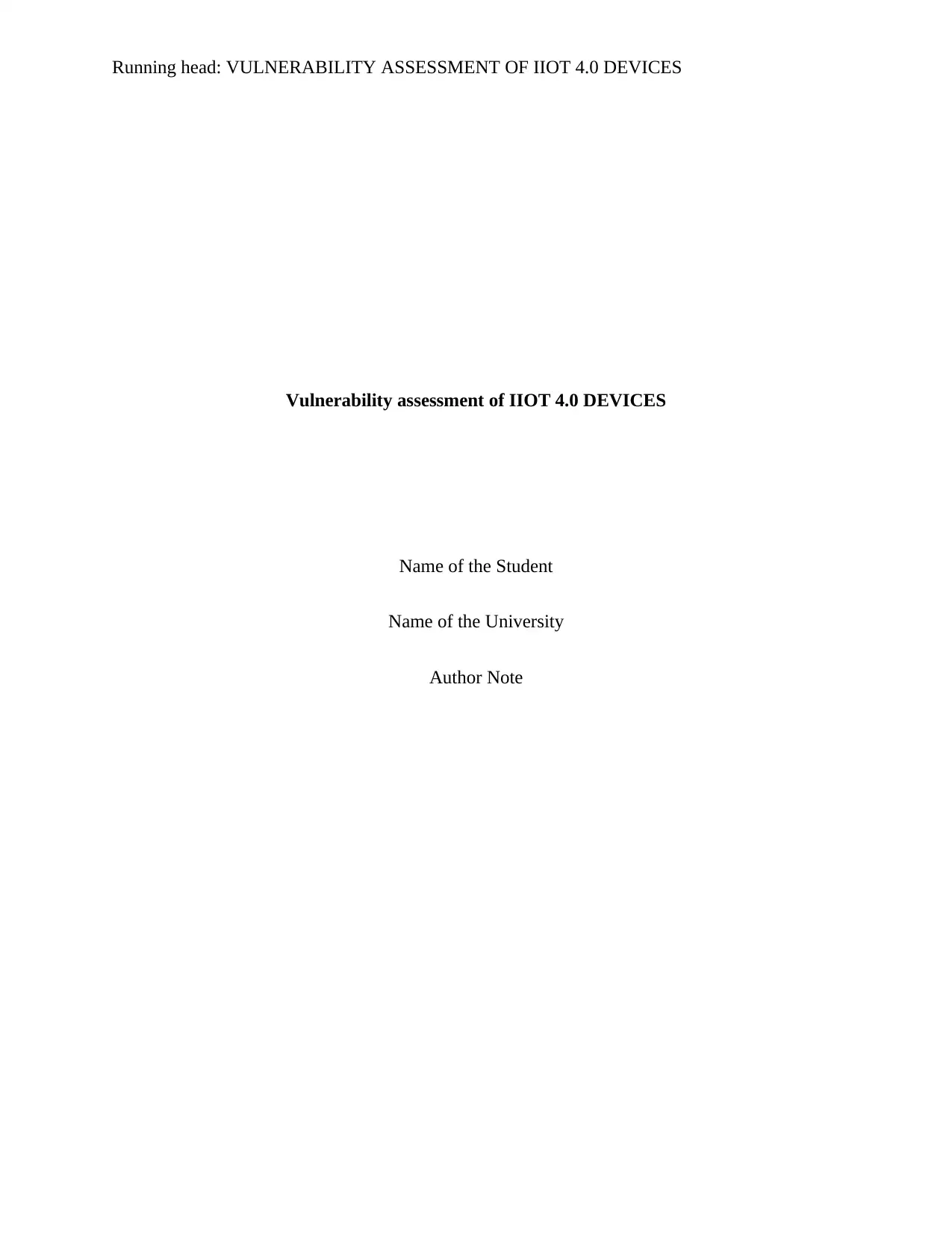
Running head: VULNERABILITY ASSESSMENT OF IIOT 4.0 DEVICES
Vulnerability assessment of IIOT 4.0 DEVICES
Name of the Student
Name of the University
Author Note
Vulnerability assessment of IIOT 4.0 DEVICES
Name of the Student
Name of the University
Author Note
Paraphrase This Document
Need a fresh take? Get an instant paraphrase of this document with our AI Paraphraser

VULNERABILITY ASSESSMENT OF IIOT 4.0 DEVICES
ACKNOWLEDGEMENT
ACKNOWLEDGEMENT

VULNERABILITY ASSESSMENT OF IIOT 4.0 DEVICES
Executive Summary
Executive Summary
⊘ This is a preview!⊘
Do you want full access?
Subscribe today to unlock all pages.

Trusted by 1+ million students worldwide
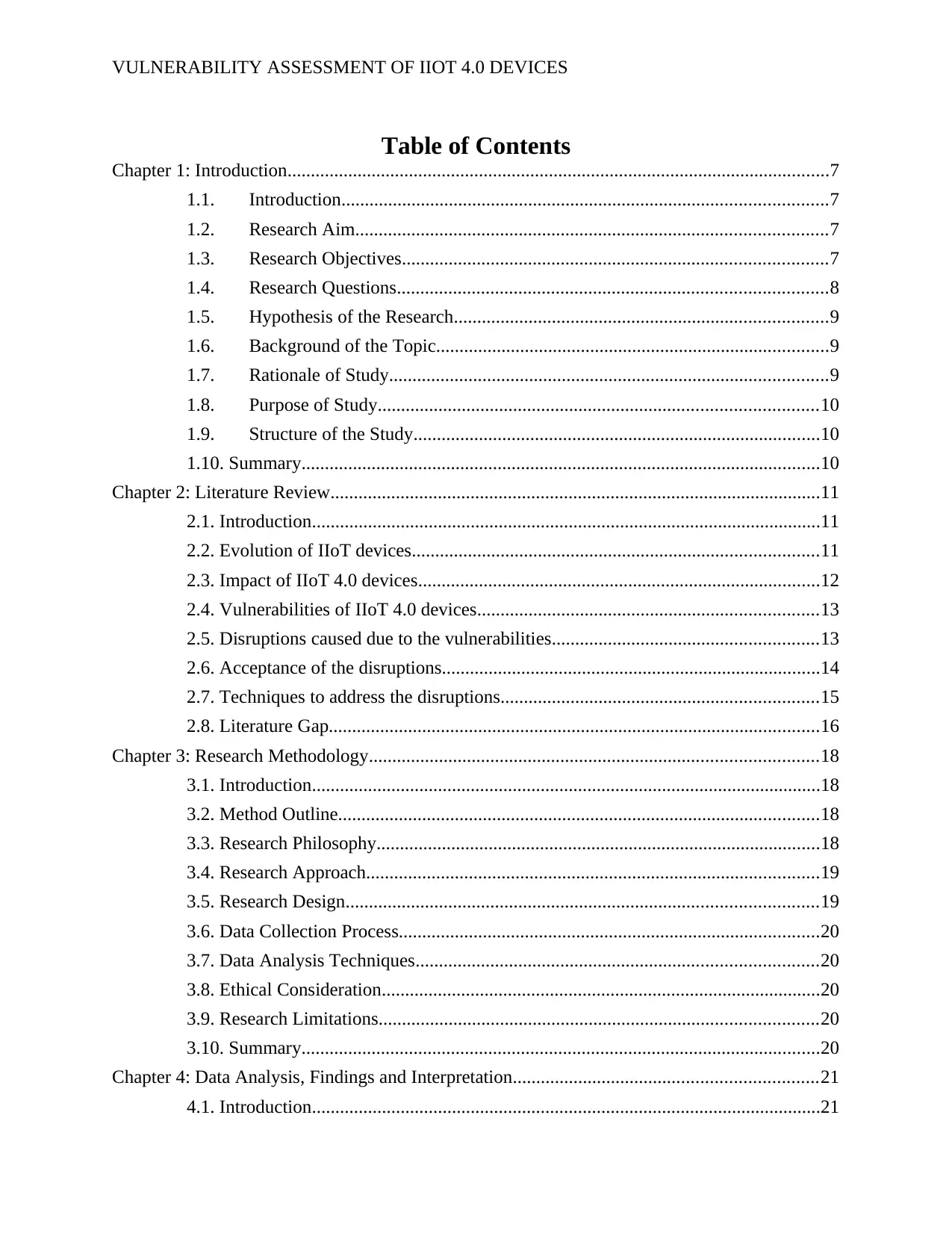
VULNERABILITY ASSESSMENT OF IIOT 4.0 DEVICES
Table of Contents
Chapter 1: Introduction....................................................................................................................7
1.1. Introduction........................................................................................................7
1.2. Research Aim.....................................................................................................7
1.3. Research Objectives...........................................................................................7
1.4. Research Questions............................................................................................8
1.5. Hypothesis of the Research................................................................................9
1.6. Background of the Topic....................................................................................9
1.7. Rationale of Study..............................................................................................9
1.8. Purpose of Study..............................................................................................10
1.9. Structure of the Study.......................................................................................10
1.10. Summary...............................................................................................................10
Chapter 2: Literature Review.........................................................................................................11
2.1. Introduction.............................................................................................................11
2.2. Evolution of IIoT devices.......................................................................................11
2.3. Impact of IIoT 4.0 devices......................................................................................12
2.4. Vulnerabilities of IIoT 4.0 devices.........................................................................13
2.5. Disruptions caused due to the vulnerabilities.........................................................13
2.6. Acceptance of the disruptions.................................................................................14
2.7. Techniques to address the disruptions....................................................................15
2.8. Literature Gap.........................................................................................................16
Chapter 3: Research Methodology................................................................................................18
3.1. Introduction.............................................................................................................18
3.2. Method Outline.......................................................................................................18
3.3. Research Philosophy...............................................................................................18
3.4. Research Approach.................................................................................................19
3.5. Research Design.....................................................................................................19
3.6. Data Collection Process..........................................................................................20
3.7. Data Analysis Techniques......................................................................................20
3.8. Ethical Consideration..............................................................................................20
3.9. Research Limitations..............................................................................................20
3.10. Summary...............................................................................................................20
Chapter 4: Data Analysis, Findings and Interpretation.................................................................21
4.1. Introduction.............................................................................................................21
Table of Contents
Chapter 1: Introduction....................................................................................................................7
1.1. Introduction........................................................................................................7
1.2. Research Aim.....................................................................................................7
1.3. Research Objectives...........................................................................................7
1.4. Research Questions............................................................................................8
1.5. Hypothesis of the Research................................................................................9
1.6. Background of the Topic....................................................................................9
1.7. Rationale of Study..............................................................................................9
1.8. Purpose of Study..............................................................................................10
1.9. Structure of the Study.......................................................................................10
1.10. Summary...............................................................................................................10
Chapter 2: Literature Review.........................................................................................................11
2.1. Introduction.............................................................................................................11
2.2. Evolution of IIoT devices.......................................................................................11
2.3. Impact of IIoT 4.0 devices......................................................................................12
2.4. Vulnerabilities of IIoT 4.0 devices.........................................................................13
2.5. Disruptions caused due to the vulnerabilities.........................................................13
2.6. Acceptance of the disruptions.................................................................................14
2.7. Techniques to address the disruptions....................................................................15
2.8. Literature Gap.........................................................................................................16
Chapter 3: Research Methodology................................................................................................18
3.1. Introduction.............................................................................................................18
3.2. Method Outline.......................................................................................................18
3.3. Research Philosophy...............................................................................................18
3.4. Research Approach.................................................................................................19
3.5. Research Design.....................................................................................................19
3.6. Data Collection Process..........................................................................................20
3.7. Data Analysis Techniques......................................................................................20
3.8. Ethical Consideration..............................................................................................20
3.9. Research Limitations..............................................................................................20
3.10. Summary...............................................................................................................20
Chapter 4: Data Analysis, Findings and Interpretation.................................................................21
4.1. Introduction.............................................................................................................21
Paraphrase This Document
Need a fresh take? Get an instant paraphrase of this document with our AI Paraphraser
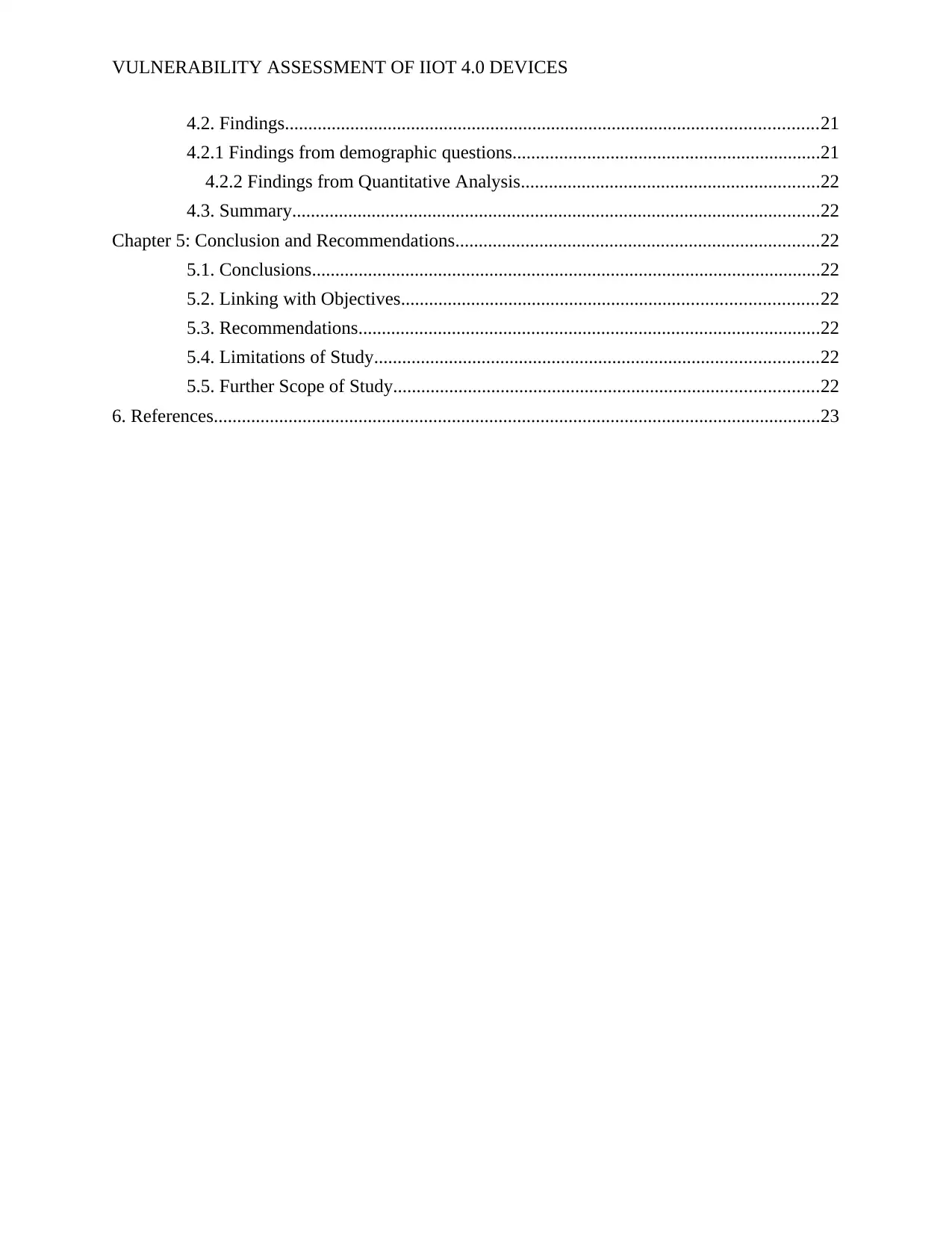
VULNERABILITY ASSESSMENT OF IIOT 4.0 DEVICES
4.2. Findings..................................................................................................................21
4.2.1 Findings from demographic questions..................................................................21
4.2.2 Findings from Quantitative Analysis................................................................22
4.3. Summary.................................................................................................................22
Chapter 5: Conclusion and Recommendations..............................................................................22
5.1. Conclusions.............................................................................................................22
5.2. Linking with Objectives.........................................................................................22
5.3. Recommendations...................................................................................................22
5.4. Limitations of Study...............................................................................................22
5.5. Further Scope of Study...........................................................................................22
6. References..................................................................................................................................23
4.2. Findings..................................................................................................................21
4.2.1 Findings from demographic questions..................................................................21
4.2.2 Findings from Quantitative Analysis................................................................22
4.3. Summary.................................................................................................................22
Chapter 5: Conclusion and Recommendations..............................................................................22
5.1. Conclusions.............................................................................................................22
5.2. Linking with Objectives.........................................................................................22
5.3. Recommendations...................................................................................................22
5.4. Limitations of Study...............................................................................................22
5.5. Further Scope of Study...........................................................................................22
6. References..................................................................................................................................23
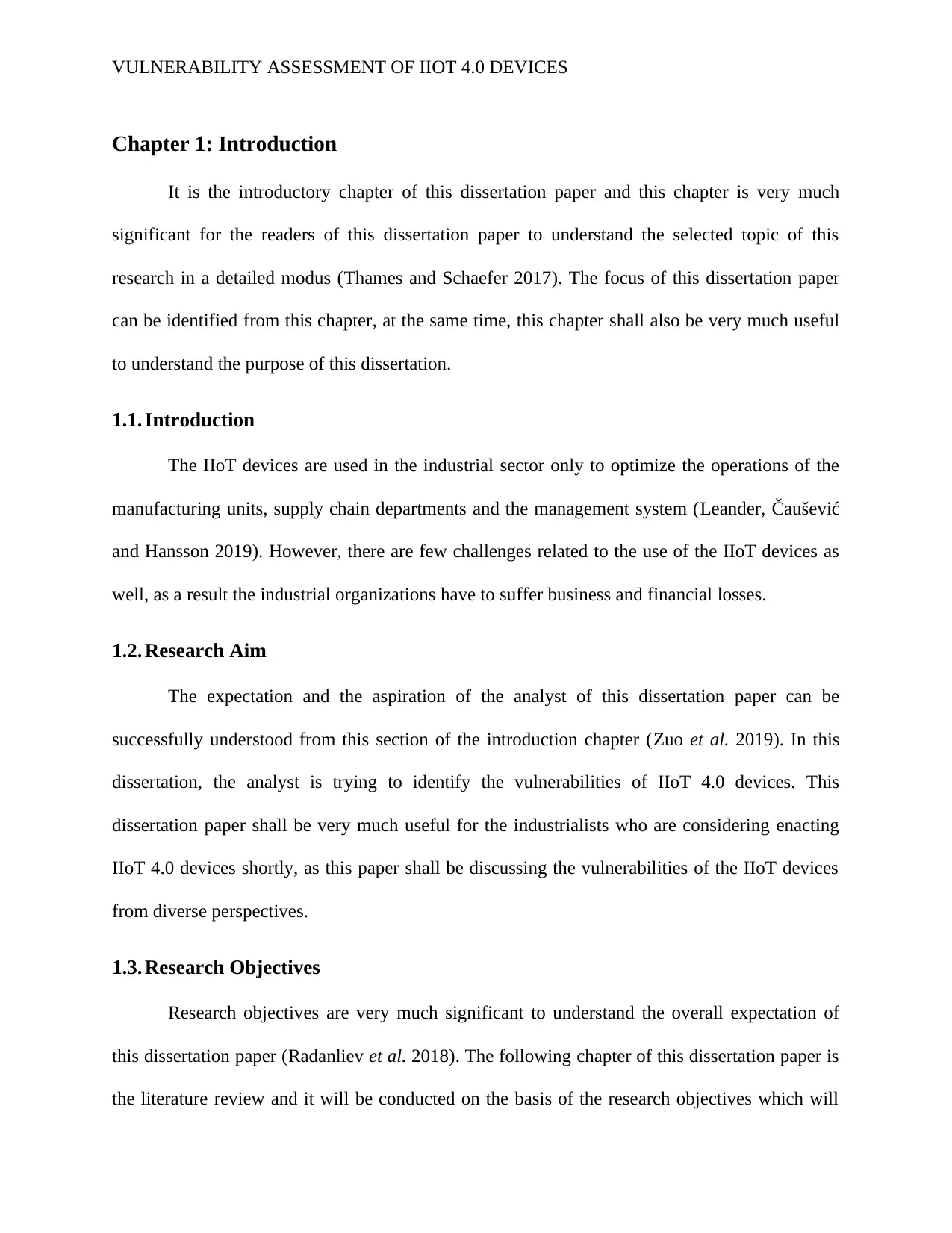
VULNERABILITY ASSESSMENT OF IIOT 4.0 DEVICES
Chapter 1: Introduction
It is the introductory chapter of this dissertation paper and this chapter is very much
significant for the readers of this dissertation paper to understand the selected topic of this
research in a detailed modus (Thames and Schaefer 2017). The focus of this dissertation paper
can be identified from this chapter, at the same time, this chapter shall also be very much useful
to understand the purpose of this dissertation.
1.1. Introduction
The IIoT devices are used in the industrial sector only to optimize the operations of the
manufacturing units, supply chain departments and the management system (Leander, Čaušević
and Hansson 2019). However, there are few challenges related to the use of the IIoT devices as
well, as a result the industrial organizations have to suffer business and financial losses.
1.2. Research Aim
The expectation and the aspiration of the analyst of this dissertation paper can be
successfully understood from this section of the introduction chapter (Zuo et al. 2019). In this
dissertation, the analyst is trying to identify the vulnerabilities of IIoT 4.0 devices. This
dissertation paper shall be very much useful for the industrialists who are considering enacting
IIoT 4.0 devices shortly, as this paper shall be discussing the vulnerabilities of the IIoT devices
from diverse perspectives.
1.3. Research Objectives
Research objectives are very much significant to understand the overall expectation of
this dissertation paper (Radanliev et al. 2018). The following chapter of this dissertation paper is
the literature review and it will be conducted on the basis of the research objectives which will
Chapter 1: Introduction
It is the introductory chapter of this dissertation paper and this chapter is very much
significant for the readers of this dissertation paper to understand the selected topic of this
research in a detailed modus (Thames and Schaefer 2017). The focus of this dissertation paper
can be identified from this chapter, at the same time, this chapter shall also be very much useful
to understand the purpose of this dissertation.
1.1. Introduction
The IIoT devices are used in the industrial sector only to optimize the operations of the
manufacturing units, supply chain departments and the management system (Leander, Čaušević
and Hansson 2019). However, there are few challenges related to the use of the IIoT devices as
well, as a result the industrial organizations have to suffer business and financial losses.
1.2. Research Aim
The expectation and the aspiration of the analyst of this dissertation paper can be
successfully understood from this section of the introduction chapter (Zuo et al. 2019). In this
dissertation, the analyst is trying to identify the vulnerabilities of IIoT 4.0 devices. This
dissertation paper shall be very much useful for the industrialists who are considering enacting
IIoT 4.0 devices shortly, as this paper shall be discussing the vulnerabilities of the IIoT devices
from diverse perspectives.
1.3. Research Objectives
Research objectives are very much significant to understand the overall expectation of
this dissertation paper (Radanliev et al. 2018). The following chapter of this dissertation paper is
the literature review and it will be conducted on the basis of the research objectives which will
⊘ This is a preview!⊘
Do you want full access?
Subscribe today to unlock all pages.

Trusted by 1+ million students worldwide
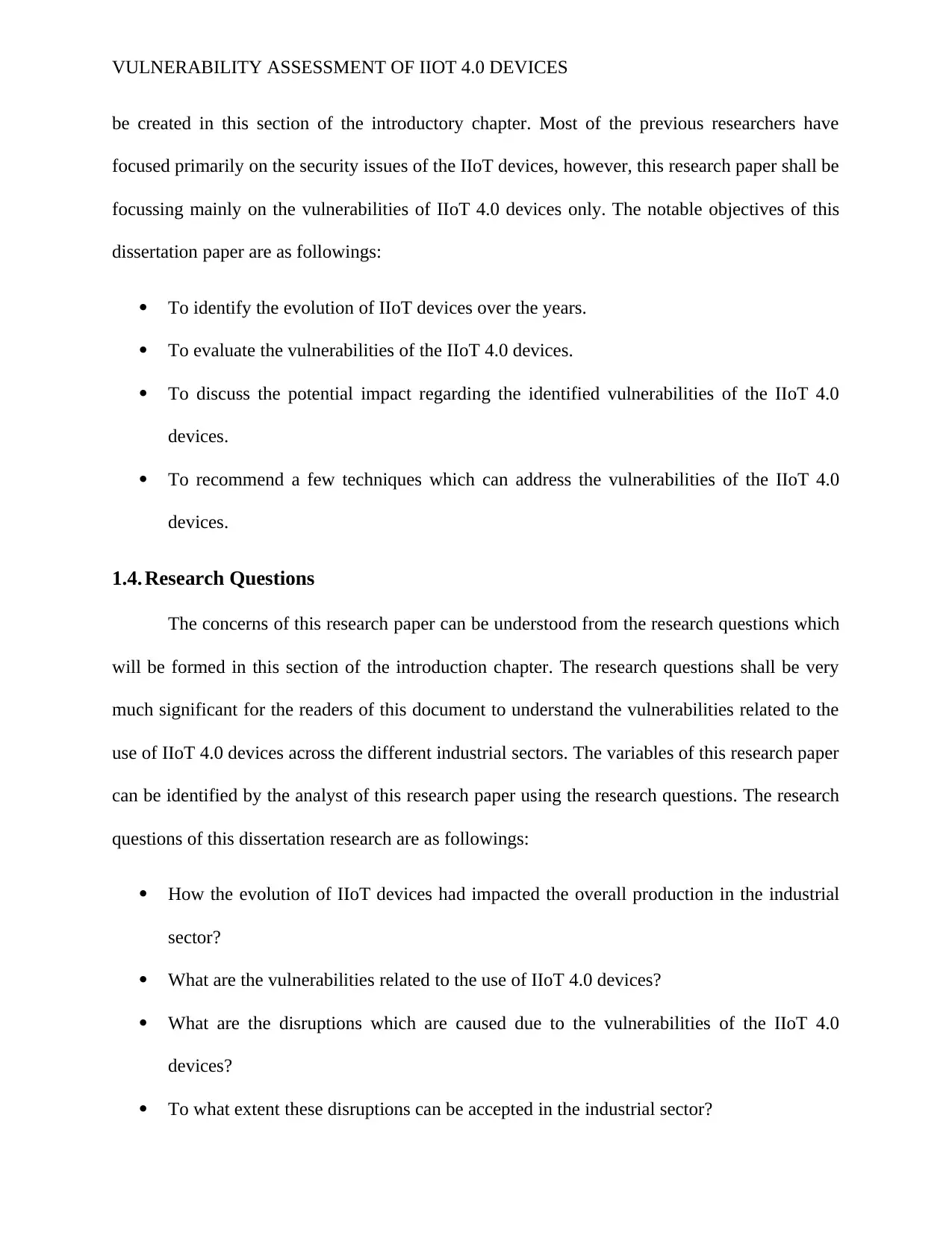
VULNERABILITY ASSESSMENT OF IIOT 4.0 DEVICES
be created in this section of the introductory chapter. Most of the previous researchers have
focused primarily on the security issues of the IIoT devices, however, this research paper shall be
focussing mainly on the vulnerabilities of IIoT 4.0 devices only. The notable objectives of this
dissertation paper are as followings:
To identify the evolution of IIoT devices over the years.
To evaluate the vulnerabilities of the IIoT 4.0 devices.
To discuss the potential impact regarding the identified vulnerabilities of the IIoT 4.0
devices.
To recommend a few techniques which can address the vulnerabilities of the IIoT 4.0
devices.
1.4. Research Questions
The concerns of this research paper can be understood from the research questions which
will be formed in this section of the introduction chapter. The research questions shall be very
much significant for the readers of this document to understand the vulnerabilities related to the
use of IIoT 4.0 devices across the different industrial sectors. The variables of this research paper
can be identified by the analyst of this research paper using the research questions. The research
questions of this dissertation research are as followings:
How the evolution of IIoT devices had impacted the overall production in the industrial
sector?
What are the vulnerabilities related to the use of IIoT 4.0 devices?
What are the disruptions which are caused due to the vulnerabilities of the IIoT 4.0
devices?
To what extent these disruptions can be accepted in the industrial sector?
be created in this section of the introductory chapter. Most of the previous researchers have
focused primarily on the security issues of the IIoT devices, however, this research paper shall be
focussing mainly on the vulnerabilities of IIoT 4.0 devices only. The notable objectives of this
dissertation paper are as followings:
To identify the evolution of IIoT devices over the years.
To evaluate the vulnerabilities of the IIoT 4.0 devices.
To discuss the potential impact regarding the identified vulnerabilities of the IIoT 4.0
devices.
To recommend a few techniques which can address the vulnerabilities of the IIoT 4.0
devices.
1.4. Research Questions
The concerns of this research paper can be understood from the research questions which
will be formed in this section of the introduction chapter. The research questions shall be very
much significant for the readers of this document to understand the vulnerabilities related to the
use of IIoT 4.0 devices across the different industrial sectors. The variables of this research paper
can be identified by the analyst of this research paper using the research questions. The research
questions of this dissertation research are as followings:
How the evolution of IIoT devices had impacted the overall production in the industrial
sector?
What are the vulnerabilities related to the use of IIoT 4.0 devices?
What are the disruptions which are caused due to the vulnerabilities of the IIoT 4.0
devices?
To what extent these disruptions can be accepted in the industrial sector?
Paraphrase This Document
Need a fresh take? Get an instant paraphrase of this document with our AI Paraphraser
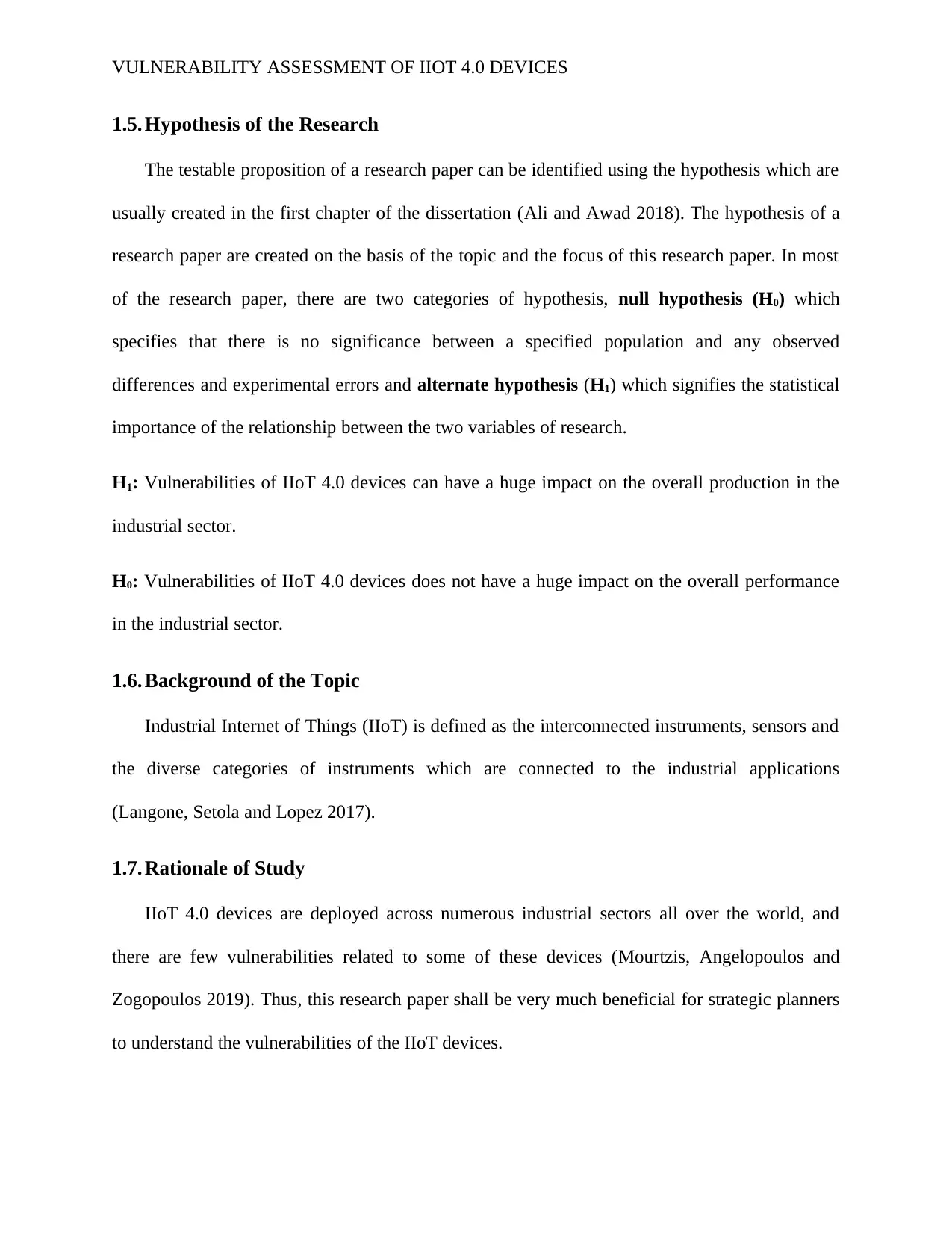
VULNERABILITY ASSESSMENT OF IIOT 4.0 DEVICES
1.5. Hypothesis of the Research
The testable proposition of a research paper can be identified using the hypothesis which are
usually created in the first chapter of the dissertation (Ali and Awad 2018). The hypothesis of a
research paper are created on the basis of the topic and the focus of this research paper. In most
of the research paper, there are two categories of hypothesis, null hypothesis (H0) which
specifies that there is no significance between a specified population and any observed
differences and experimental errors and alternate hypothesis (H1) which signifies the statistical
importance of the relationship between the two variables of research.
H1: Vulnerabilities of IIoT 4.0 devices can have a huge impact on the overall production in the
industrial sector.
H0: Vulnerabilities of IIoT 4.0 devices does not have a huge impact on the overall performance
in the industrial sector.
1.6. Background of the Topic
Industrial Internet of Things (IIoT) is defined as the interconnected instruments, sensors and
the diverse categories of instruments which are connected to the industrial applications
(Langone, Setola and Lopez 2017).
1.7. Rationale of Study
IIoT 4.0 devices are deployed across numerous industrial sectors all over the world, and
there are few vulnerabilities related to some of these devices (Mourtzis, Angelopoulos and
Zogopoulos 2019). Thus, this research paper shall be very much beneficial for strategic planners
to understand the vulnerabilities of the IIoT devices.
1.5. Hypothesis of the Research
The testable proposition of a research paper can be identified using the hypothesis which are
usually created in the first chapter of the dissertation (Ali and Awad 2018). The hypothesis of a
research paper are created on the basis of the topic and the focus of this research paper. In most
of the research paper, there are two categories of hypothesis, null hypothesis (H0) which
specifies that there is no significance between a specified population and any observed
differences and experimental errors and alternate hypothesis (H1) which signifies the statistical
importance of the relationship between the two variables of research.
H1: Vulnerabilities of IIoT 4.0 devices can have a huge impact on the overall production in the
industrial sector.
H0: Vulnerabilities of IIoT 4.0 devices does not have a huge impact on the overall performance
in the industrial sector.
1.6. Background of the Topic
Industrial Internet of Things (IIoT) is defined as the interconnected instruments, sensors and
the diverse categories of instruments which are connected to the industrial applications
(Langone, Setola and Lopez 2017).
1.7. Rationale of Study
IIoT 4.0 devices are deployed across numerous industrial sectors all over the world, and
there are few vulnerabilities related to some of these devices (Mourtzis, Angelopoulos and
Zogopoulos 2019). Thus, this research paper shall be very much beneficial for strategic planners
to understand the vulnerabilities of the IIoT devices.
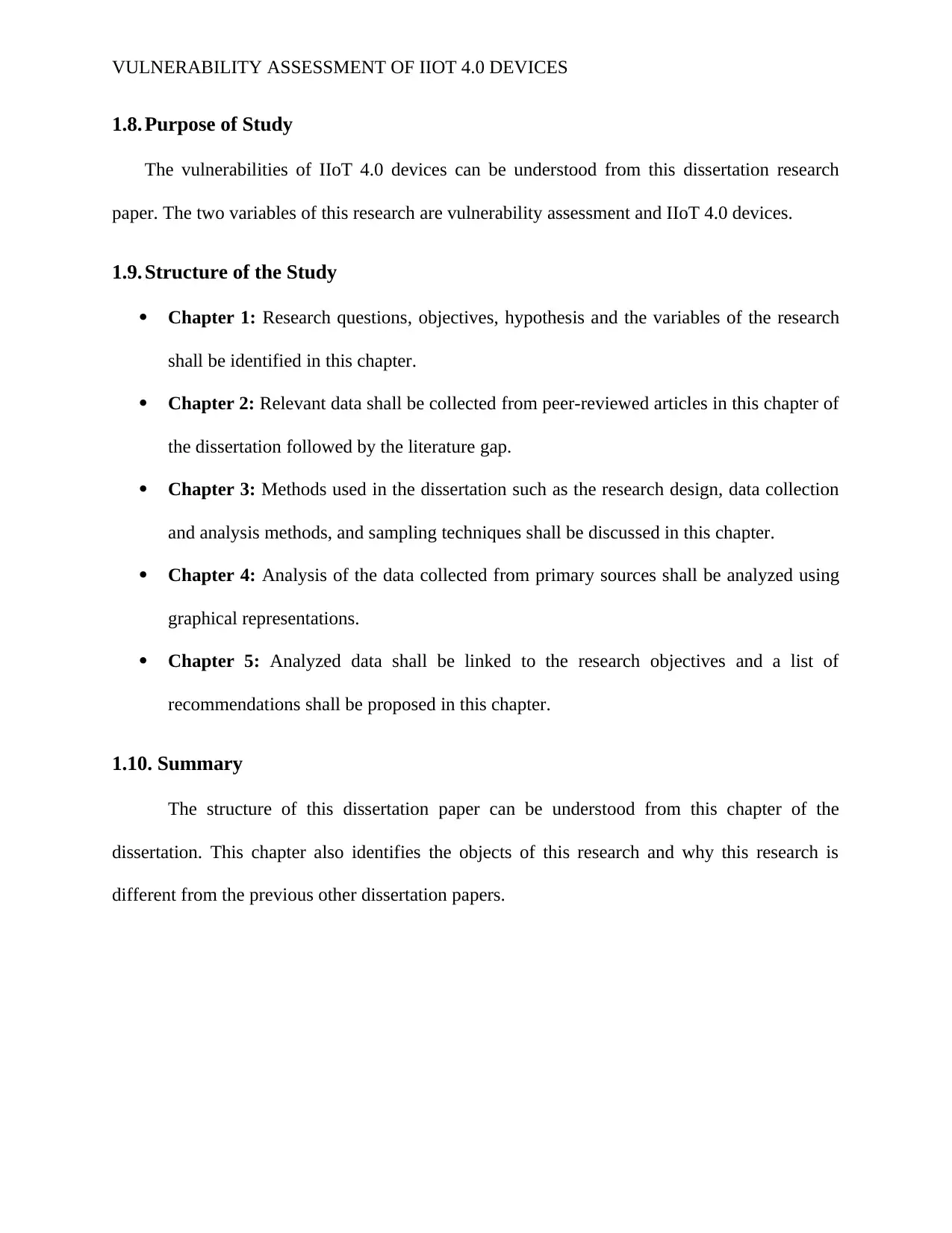
VULNERABILITY ASSESSMENT OF IIOT 4.0 DEVICES
1.8. Purpose of Study
The vulnerabilities of IIoT 4.0 devices can be understood from this dissertation research
paper. The two variables of this research are vulnerability assessment and IIoT 4.0 devices.
1.9. Structure of the Study
Chapter 1: Research questions, objectives, hypothesis and the variables of the research
shall be identified in this chapter.
Chapter 2: Relevant data shall be collected from peer-reviewed articles in this chapter of
the dissertation followed by the literature gap.
Chapter 3: Methods used in the dissertation such as the research design, data collection
and analysis methods, and sampling techniques shall be discussed in this chapter.
Chapter 4: Analysis of the data collected from primary sources shall be analyzed using
graphical representations.
Chapter 5: Analyzed data shall be linked to the research objectives and a list of
recommendations shall be proposed in this chapter.
1.10. Summary
The structure of this dissertation paper can be understood from this chapter of the
dissertation. This chapter also identifies the objects of this research and why this research is
different from the previous other dissertation papers.
1.8. Purpose of Study
The vulnerabilities of IIoT 4.0 devices can be understood from this dissertation research
paper. The two variables of this research are vulnerability assessment and IIoT 4.0 devices.
1.9. Structure of the Study
Chapter 1: Research questions, objectives, hypothesis and the variables of the research
shall be identified in this chapter.
Chapter 2: Relevant data shall be collected from peer-reviewed articles in this chapter of
the dissertation followed by the literature gap.
Chapter 3: Methods used in the dissertation such as the research design, data collection
and analysis methods, and sampling techniques shall be discussed in this chapter.
Chapter 4: Analysis of the data collected from primary sources shall be analyzed using
graphical representations.
Chapter 5: Analyzed data shall be linked to the research objectives and a list of
recommendations shall be proposed in this chapter.
1.10. Summary
The structure of this dissertation paper can be understood from this chapter of the
dissertation. This chapter also identifies the objects of this research and why this research is
different from the previous other dissertation papers.
⊘ This is a preview!⊘
Do you want full access?
Subscribe today to unlock all pages.

Trusted by 1+ million students worldwide
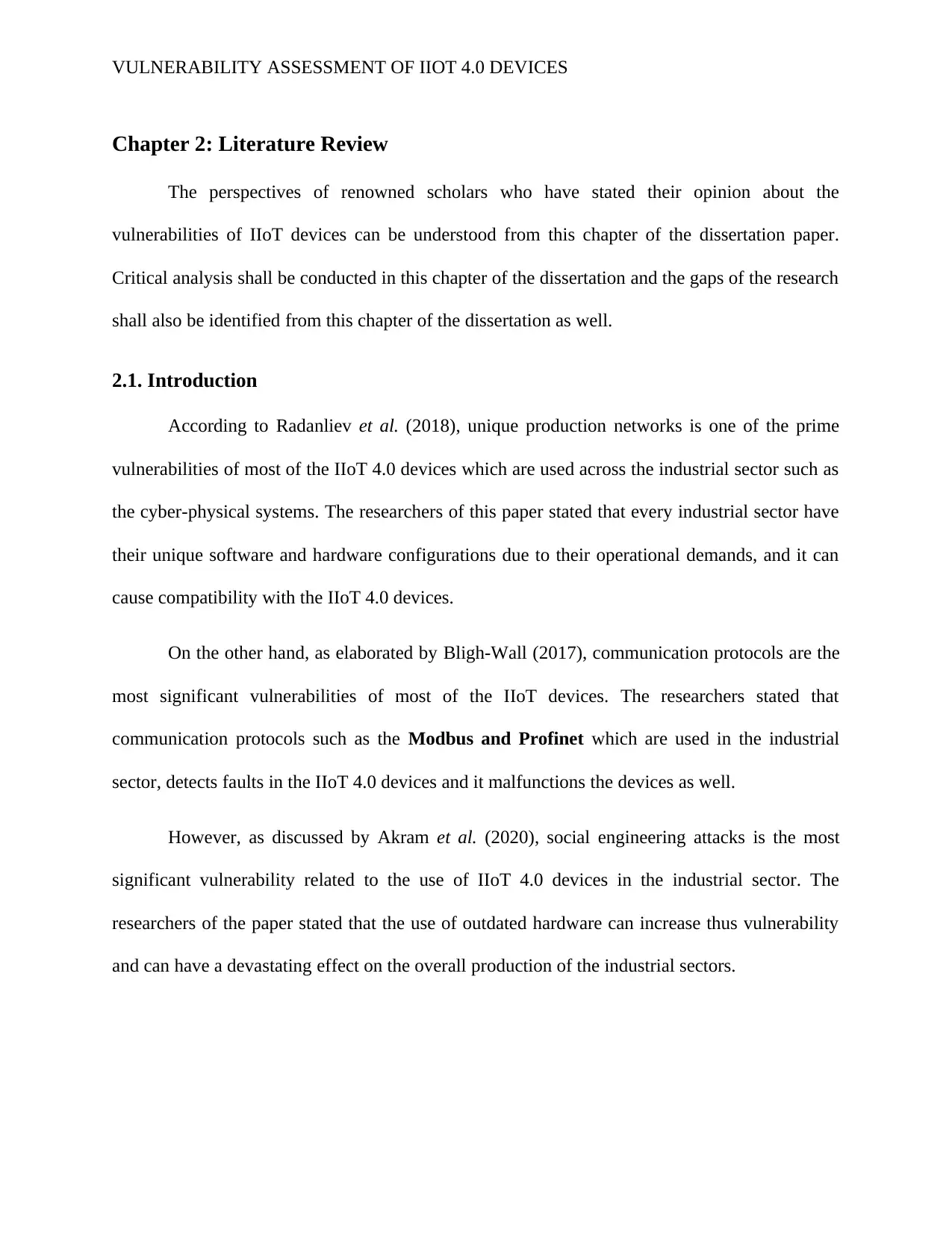
VULNERABILITY ASSESSMENT OF IIOT 4.0 DEVICES
Chapter 2: Literature Review
The perspectives of renowned scholars who have stated their opinion about the
vulnerabilities of IIoT devices can be understood from this chapter of the dissertation paper.
Critical analysis shall be conducted in this chapter of the dissertation and the gaps of the research
shall also be identified from this chapter of the dissertation as well.
2.1. Introduction
According to Radanliev et al. (2018), unique production networks is one of the prime
vulnerabilities of most of the IIoT 4.0 devices which are used across the industrial sector such as
the cyber-physical systems. The researchers of this paper stated that every industrial sector have
their unique software and hardware configurations due to their operational demands, and it can
cause compatibility with the IIoT 4.0 devices.
On the other hand, as elaborated by Bligh-Wall (2017), communication protocols are the
most significant vulnerabilities of most of the IIoT devices. The researchers stated that
communication protocols such as the Modbus and Profinet which are used in the industrial
sector, detects faults in the IIoT 4.0 devices and it malfunctions the devices as well.
However, as discussed by Akram et al. (2020), social engineering attacks is the most
significant vulnerability related to the use of IIoT 4.0 devices in the industrial sector. The
researchers of the paper stated that the use of outdated hardware can increase thus vulnerability
and can have a devastating effect on the overall production of the industrial sectors.
Chapter 2: Literature Review
The perspectives of renowned scholars who have stated their opinion about the
vulnerabilities of IIoT devices can be understood from this chapter of the dissertation paper.
Critical analysis shall be conducted in this chapter of the dissertation and the gaps of the research
shall also be identified from this chapter of the dissertation as well.
2.1. Introduction
According to Radanliev et al. (2018), unique production networks is one of the prime
vulnerabilities of most of the IIoT 4.0 devices which are used across the industrial sector such as
the cyber-physical systems. The researchers of this paper stated that every industrial sector have
their unique software and hardware configurations due to their operational demands, and it can
cause compatibility with the IIoT 4.0 devices.
On the other hand, as elaborated by Bligh-Wall (2017), communication protocols are the
most significant vulnerabilities of most of the IIoT devices. The researchers stated that
communication protocols such as the Modbus and Profinet which are used in the industrial
sector, detects faults in the IIoT 4.0 devices and it malfunctions the devices as well.
However, as discussed by Akram et al. (2020), social engineering attacks is the most
significant vulnerability related to the use of IIoT 4.0 devices in the industrial sector. The
researchers of the paper stated that the use of outdated hardware can increase thus vulnerability
and can have a devastating effect on the overall production of the industrial sectors.
Paraphrase This Document
Need a fresh take? Get an instant paraphrase of this document with our AI Paraphraser
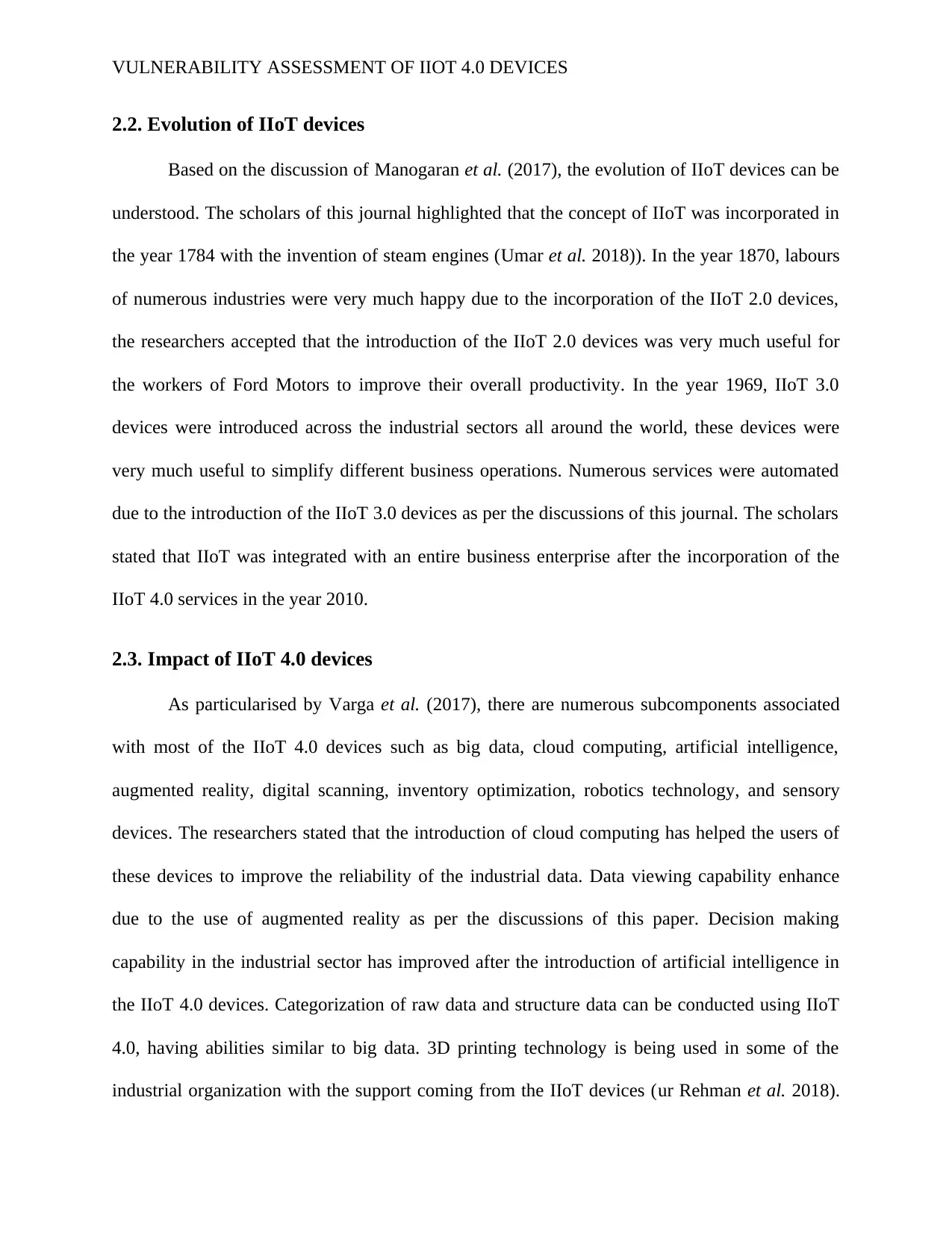
VULNERABILITY ASSESSMENT OF IIOT 4.0 DEVICES
2.2. Evolution of IIoT devices
Based on the discussion of Manogaran et al. (2017), the evolution of IIoT devices can be
understood. The scholars of this journal highlighted that the concept of IIoT was incorporated in
the year 1784 with the invention of steam engines (Umar et al. 2018)). In the year 1870, labours
of numerous industries were very much happy due to the incorporation of the IIoT 2.0 devices,
the researchers accepted that the introduction of the IIoT 2.0 devices was very much useful for
the workers of Ford Motors to improve their overall productivity. In the year 1969, IIoT 3.0
devices were introduced across the industrial sectors all around the world, these devices were
very much useful to simplify different business operations. Numerous services were automated
due to the introduction of the IIoT 3.0 devices as per the discussions of this journal. The scholars
stated that IIoT was integrated with an entire business enterprise after the incorporation of the
IIoT 4.0 services in the year 2010.
2.3. Impact of IIoT 4.0 devices
As particularised by Varga et al. (2017), there are numerous subcomponents associated
with most of the IIoT 4.0 devices such as big data, cloud computing, artificial intelligence,
augmented reality, digital scanning, inventory optimization, robotics technology, and sensory
devices. The researchers stated that the introduction of cloud computing has helped the users of
these devices to improve the reliability of the industrial data. Data viewing capability enhance
due to the use of augmented reality as per the discussions of this paper. Decision making
capability in the industrial sector has improved after the introduction of artificial intelligence in
the IIoT 4.0 devices. Categorization of raw data and structure data can be conducted using IIoT
4.0, having abilities similar to big data. 3D printing technology is being used in some of the
industrial organization with the support coming from the IIoT devices (ur Rehman et al. 2018).
2.2. Evolution of IIoT devices
Based on the discussion of Manogaran et al. (2017), the evolution of IIoT devices can be
understood. The scholars of this journal highlighted that the concept of IIoT was incorporated in
the year 1784 with the invention of steam engines (Umar et al. 2018)). In the year 1870, labours
of numerous industries were very much happy due to the incorporation of the IIoT 2.0 devices,
the researchers accepted that the introduction of the IIoT 2.0 devices was very much useful for
the workers of Ford Motors to improve their overall productivity. In the year 1969, IIoT 3.0
devices were introduced across the industrial sectors all around the world, these devices were
very much useful to simplify different business operations. Numerous services were automated
due to the introduction of the IIoT 3.0 devices as per the discussions of this journal. The scholars
stated that IIoT was integrated with an entire business enterprise after the incorporation of the
IIoT 4.0 services in the year 2010.
2.3. Impact of IIoT 4.0 devices
As particularised by Varga et al. (2017), there are numerous subcomponents associated
with most of the IIoT 4.0 devices such as big data, cloud computing, artificial intelligence,
augmented reality, digital scanning, inventory optimization, robotics technology, and sensory
devices. The researchers stated that the introduction of cloud computing has helped the users of
these devices to improve the reliability of the industrial data. Data viewing capability enhance
due to the use of augmented reality as per the discussions of this paper. Decision making
capability in the industrial sector has improved after the introduction of artificial intelligence in
the IIoT 4.0 devices. Categorization of raw data and structure data can be conducted using IIoT
4.0, having abilities similar to big data. 3D printing technology is being used in some of the
industrial organization with the support coming from the IIoT devices (ur Rehman et al. 2018).
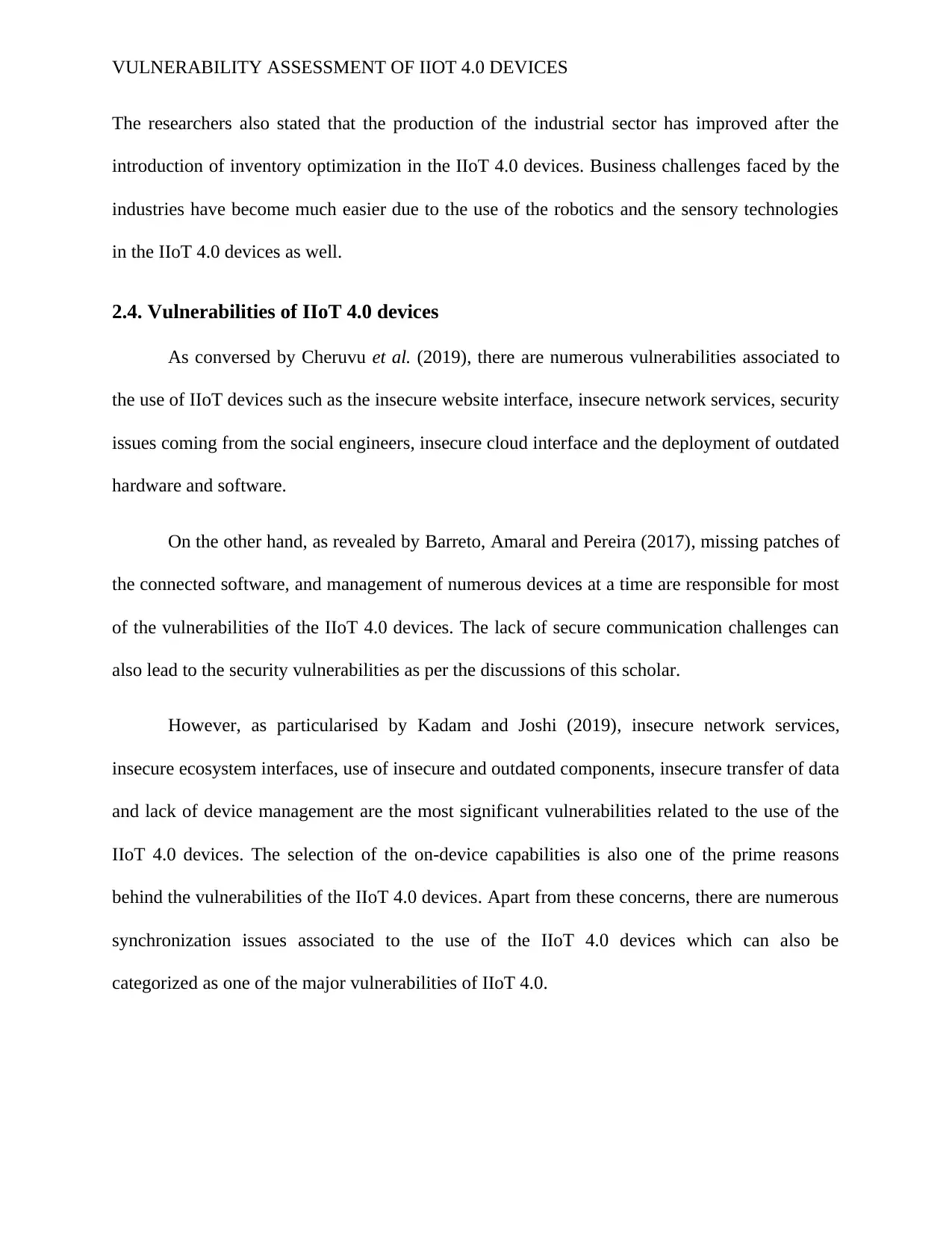
VULNERABILITY ASSESSMENT OF IIOT 4.0 DEVICES
The researchers also stated that the production of the industrial sector has improved after the
introduction of inventory optimization in the IIoT 4.0 devices. Business challenges faced by the
industries have become much easier due to the use of the robotics and the sensory technologies
in the IIoT 4.0 devices as well.
2.4. Vulnerabilities of IIoT 4.0 devices
As conversed by Cheruvu et al. (2019), there are numerous vulnerabilities associated to
the use of IIoT devices such as the insecure website interface, insecure network services, security
issues coming from the social engineers, insecure cloud interface and the deployment of outdated
hardware and software.
On the other hand, as revealed by Barreto, Amaral and Pereira (2017), missing patches of
the connected software, and management of numerous devices at a time are responsible for most
of the vulnerabilities of the IIoT 4.0 devices. The lack of secure communication challenges can
also lead to the security vulnerabilities as per the discussions of this scholar.
However, as particularised by Kadam and Joshi (2019), insecure network services,
insecure ecosystem interfaces, use of insecure and outdated components, insecure transfer of data
and lack of device management are the most significant vulnerabilities related to the use of the
IIoT 4.0 devices. The selection of the on-device capabilities is also one of the prime reasons
behind the vulnerabilities of the IIoT 4.0 devices. Apart from these concerns, there are numerous
synchronization issues associated to the use of the IIoT 4.0 devices which can also be
categorized as one of the major vulnerabilities of IIoT 4.0.
The researchers also stated that the production of the industrial sector has improved after the
introduction of inventory optimization in the IIoT 4.0 devices. Business challenges faced by the
industries have become much easier due to the use of the robotics and the sensory technologies
in the IIoT 4.0 devices as well.
2.4. Vulnerabilities of IIoT 4.0 devices
As conversed by Cheruvu et al. (2019), there are numerous vulnerabilities associated to
the use of IIoT devices such as the insecure website interface, insecure network services, security
issues coming from the social engineers, insecure cloud interface and the deployment of outdated
hardware and software.
On the other hand, as revealed by Barreto, Amaral and Pereira (2017), missing patches of
the connected software, and management of numerous devices at a time are responsible for most
of the vulnerabilities of the IIoT 4.0 devices. The lack of secure communication challenges can
also lead to the security vulnerabilities as per the discussions of this scholar.
However, as particularised by Kadam and Joshi (2019), insecure network services,
insecure ecosystem interfaces, use of insecure and outdated components, insecure transfer of data
and lack of device management are the most significant vulnerabilities related to the use of the
IIoT 4.0 devices. The selection of the on-device capabilities is also one of the prime reasons
behind the vulnerabilities of the IIoT 4.0 devices. Apart from these concerns, there are numerous
synchronization issues associated to the use of the IIoT 4.0 devices which can also be
categorized as one of the major vulnerabilities of IIoT 4.0.
⊘ This is a preview!⊘
Do you want full access?
Subscribe today to unlock all pages.

Trusted by 1+ million students worldwide
1 out of 24
Related Documents
Your All-in-One AI-Powered Toolkit for Academic Success.
+13062052269
info@desklib.com
Available 24*7 on WhatsApp / Email
![[object Object]](/_next/static/media/star-bottom.7253800d.svg)
Unlock your academic potential
Copyright © 2020–2025 A2Z Services. All Rights Reserved. Developed and managed by ZUCOL.





